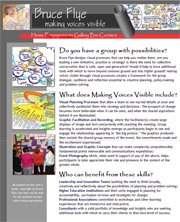 their experiences in the interest of uncovering lessons for leading in times of crisis. Among the ways that CCL wanted to capture the event was through the use of a graphic recorder, and we subsequently agreed to work together.
their experiences in the interest of uncovering lessons for leading in times of crisis. Among the ways that CCL wanted to capture the event was through the use of a graphic recorder, and we subsequently agreed to work together. Funding was provided by a private donor who asked that CCL consider something “edgy,” so the event design was a lesson unto itself. Ten leaders who had dealt with the storm and its aftermath were joined by a “discussant” team of about twenty made up of CCL faculty and representatives of various agencies. The work day began with David Horth leading a Fish Bowl, wherein participants took turns observing and participating in dialogue. That was followed by a Visual Explorer exercise, wherein participants selected an image that conveyed meaning abou t their experience in the storm, and then conveyed those feelings comprehensibly to others. This first day ended with an abbreviated form of Open Space Conversation, and then the next day began with a Mind Map created by the entire leadership group.
t their experience in the storm, and then conveyed those feelings comprehensibly to others. This first day ended with an abbreviated form of Open Space Conversation, and then the next day began with a Mind Map created by the entire leadership group.
The event concluded with a summary of the lessons learned, using a method of dialogue in which everyone could “talk and listen” at the same time. When the event began, the discussants were on networked laptops connected to each other by groupware. They could do things like keep personal journals and text message others in the room about what they were seeing and hearing. Eventually the leaders were able to join in, and this final morning concluded with everyone live and online. Specific questions were framed by a second facilitator , Jerry Abrams, and as individuals typed their thoughts into the system at the bottom of the screen, they could see what everyone else was saying at the top. Literally, about thirty people were all talking and listening at the same time.
, Jerry Abrams, and as individuals typed their thoughts into the system at the bottom of the screen, they could see what everyone else was saying at the top. Literally, about thirty people were all talking and listening at the same time.
At back of the room, things were a little simpler: markers, chalk and wide roll of paper. Usually I have to either lead the facilitation or at least co-facilitate while also producing the images; it is rare that I get a day and a half to just draw, so I made the most of it, filling about 70 square feet of paper, including the sketch pad  used during the Open Conversation. In the presence of all the sophistication and technology “just drawing” felt pretty crude – at first. I was absolutely unprepared for the reactions that were to come.
used during the Open Conversation. In the presence of all the sophistication and technology “just drawing” felt pretty crude – at first. I was absolutely unprepared for the reactions that were to come.
As the day wore on, there was constantly someone watching what I was doing, and there were small crowds at breaks. There would be comments like “That’s how it was!” Near the end of the day, David Horth asked if I wanted to talk about the work. I suggested instead that he invite the participants to take a “gallery walk” by it all, and that he might even invite them to sign it. That’s what they did, over the course of several heart-felt minutes. One of them observed “The technology certainly captured the facts, but the drawings captured the emotions.”


1 comment:
as I read your experience zI was aware of a deep emotion that rose for me as your awareness opened to 'big mind' through your choice to just be and how powerful when the the private becomes public and your heart is not hurt only healing.
Post a Comment